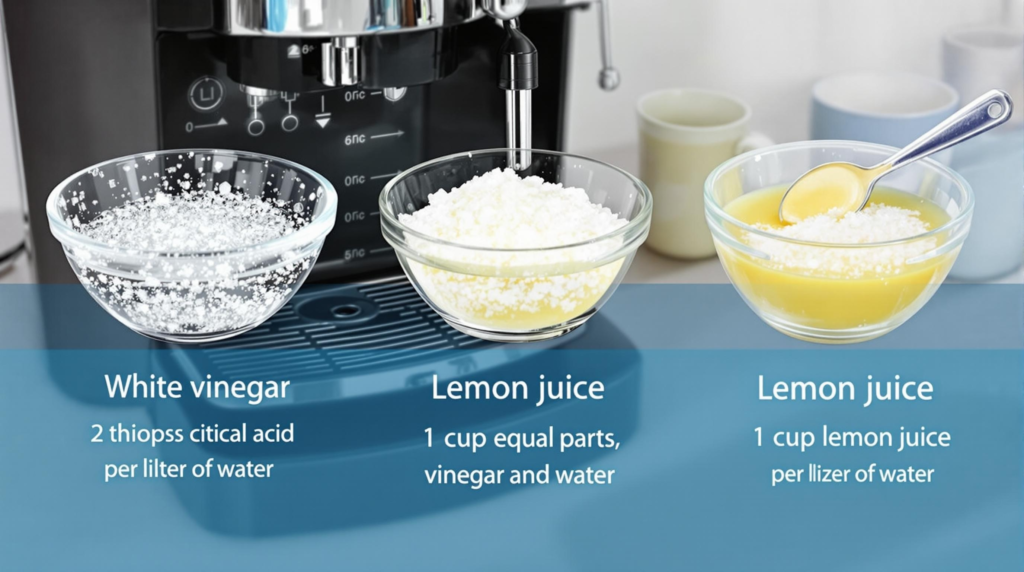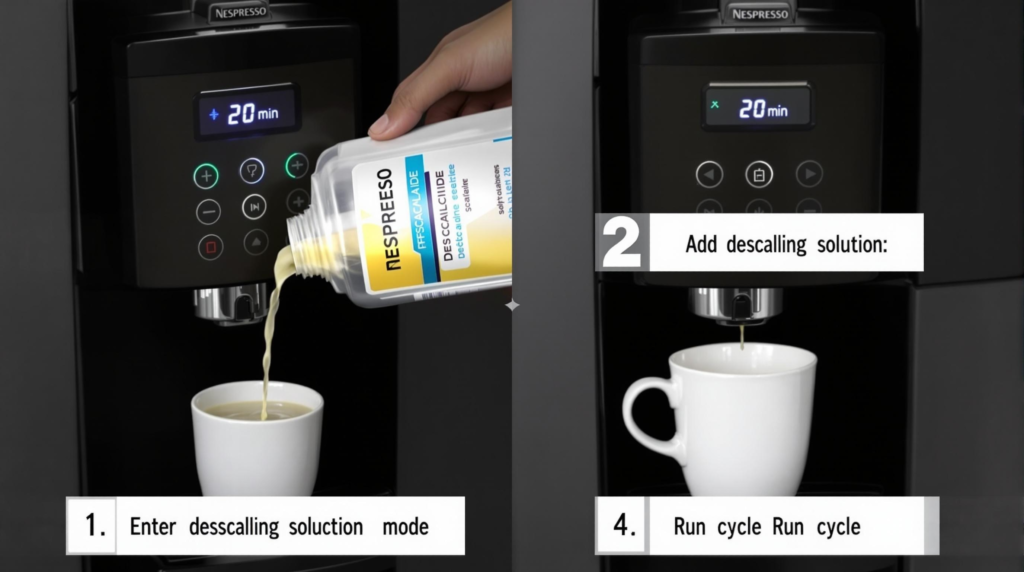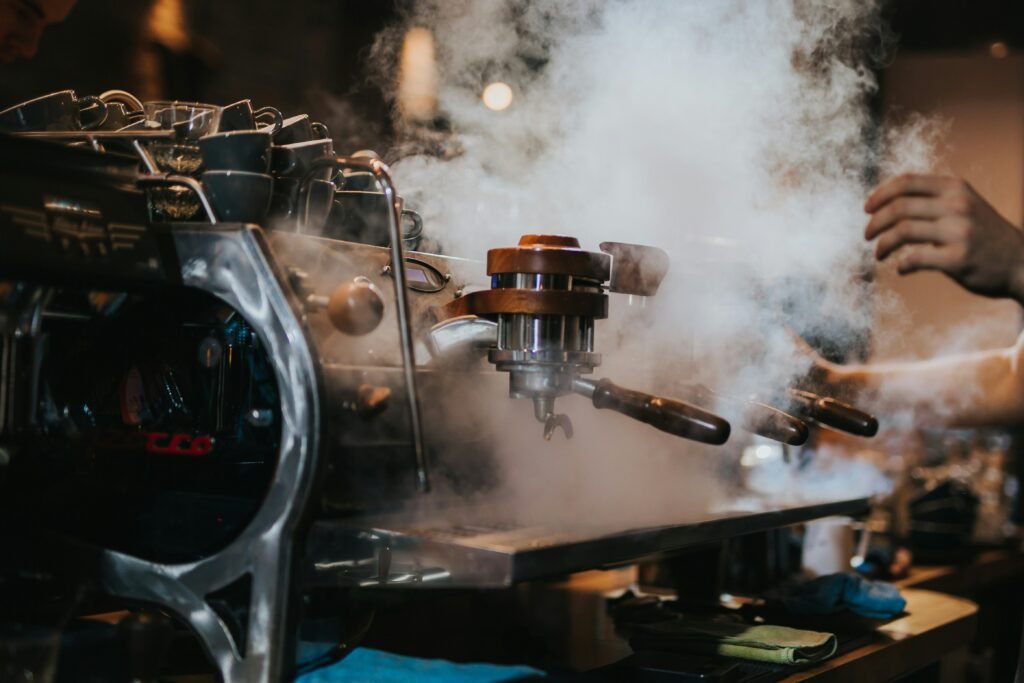Is your espresso machine producing bitter coffee or taking longer to brew? Hard water deposits are likely clogging your machine's inner workings. Without proper descaling, these mineral buildups can damage your equipment and ruin your coffee experience.
Descaling an espresso machine involves running a descaling solution through the machine to remove mineral deposits from water. For home machines, use a commercial descaler or alternatives like citric acid, vinegar, or lemon juice, following your machine's specific instructions for the cleaning cycle.
I've been working with coffee equipment for over 15 years, and I can tell you that proper maintenance is the secret to both equipment longevity and consistently great coffee. Let's explore everything you need to know about descaling your espresso machine, with professional tips I've learned from maintaining thousands of machines.
How Do I Descale My Espresso Machine At Home?
Have you noticed your espresso shots coming out slower or tasting off? These are classic signs of scale buildup, which can reduce your machine's efficiency by up to 30% and significantly shorten its lifespan.
To descale your home espresso machine, first read your manual for specific instructions. Generally, you'll empty the water tank, fill it with descaling solution mixed with water, run half through the brew head and half through the steam wand, rinse thoroughly, then run 2-3 clean water cycles.
Descaling at home doesn't have to be complicated, but attention to detail matters. I recommend establishing a regular maintenance schedule based on your water hardness and usage frequency. For most home users with average water hardness, descaling every 2-3 months is sufficient.
Here's my step-by-step process for thorough descaling:
- Preparation: Turn off your machine and let it cool completely. Remove and clean the portafilter, basket, and drip tray.
- Mix Solution: Follow the descaler manufacturer's instructions for dilution ratios, typically 1:1 with water.
- Descaling Cycle: Place a large container under the brew head and steam wand. Run about half the solution through the brew group, then the remainder through the steam wand.
- Soaking Time: For heavily scaled machines, let the solution sit for 15-20 minutes to break down stubborn deposits.
- Rinse Cycles: Empty and rinse the water tank thoroughly, then fill with fresh water. Run at least 2-3 complete tanks of clean water through both the brew head and steam wand until all traces of descaler are removed.
I've found that using a blind filter basket during the final rinse cycle helps clean the brew head's internal components more effectively. Simply lock it in and run several short "on-off" cycles to create a backflush effect that dislodges any remaining particles.
What Can I Use Instead Of Descale Solution?
Running out of commercial descaler when you notice performance issues can be frustrating. I've been there many times during service calls when the standard solution wasn't available.
Effective alternatives to commercial descaling solutions include food-grade citric acid (2 tablespoons per liter of water), white vinegar (equal parts with water), or lemon juice (1 cup per liter of water). These natural acids dissolve mineral deposits similarly to commercial products but may require longer soaking times.

In my experience working with various coffee equipment, these household alternatives can be quite effective, though they each have distinct advantages and limitations. After testing numerous methods across different machine types, I've compiled this comparison table:
| Descaling Agent | Effectiveness | Pros | Cons | Best For |
|---|---|---|---|---|
| Citric Acid | ★★★★☆ | Gentle on components, no residual taste | Requires precise measurement | Semi-automatic machines |
| White Vinegar | ★★★☆☆ | Readily available, inexpensive | Strong odor, potential taste residue | Simple machines, budget options |
| Lemon Juice | ★★★☆☆ | Natural, pleasant scent | Less consistent concentration | Emergency situations |
| Commercial Descaler | ★★★★★ | Formulated specifically for coffee equipment | More expensive, chemicals | All machine types |
When using alternatives, I always recommend increasing the rinse cycles by at least one additional full tank to ensure no acidic residues remain. From my testing, citric acid offers the best balance of effectiveness and gentleness on machine components, making it my preferred alternative to commercial solutions.
One important note: regardless of which solution you choose, never use these alternatives in superautomatic machines unless explicitly approved by the manufacturer, as they can damage sensitive internal components or void warranties.
How Do I Descale My Nespresso Espresso Machine?
When I first started working with Nespresso machines, I was surprised by how quickly scale could affect these compact systems. Their smaller water pathways are particularly vulnerable to mineral buildup.
To descale a Nespresso machine, enter descaling mode (usually by pressing specific button combinations detailed in your manual), add Nespresso descaling solution to the water tank, place a container under the spout, and follow the prompts to complete the automated descaling cycle, which takes about 20 minutes.

Nespresso machines have specific maintenance requirements that differ slightly between models. I've maintained dozens of these machines and found that following the manufacturer's protocols is essential for these sophisticated systems.
For most Nespresso machines, the descaling process follows this pattern:
VertuoLine Models:
- Enter descaling mode by pressing both buttons for 3 seconds until they start blinking
- Empty the drip tray and used capsule container
- Fill the water tank with one unit of descaling solution and 17 oz of water
- Place a container (minimum 34 oz) under the coffee outlet
- Press the button to start the descaling cycle
- Once complete, rinse the water tank and refill with fresh water
- Run a rinse cycle by pressing the button again
OriginalLine Models:
- Turn on the machine and wait for buttons to stop blinking
- Enter descaling mode by pressing both buttons for 3 seconds
- Fill the water tank with descaling solution and water
- Place a container under the coffee outlet
- Press the lungo button and let the solution run through
- Refill the used solution and repeat until "empty tank" light illuminates
- Rinse the water tank thoroughly and fill with fresh water
- Press lungo button again to rinse the machine
I always make sure to use only Nespresso-approved descaling solutions for these machines. Using unapproved alternatives can damage the internal components and potentially void your warranty.
Is Descaling An Espresso Machine Necessary?
After years of repairing expensive espresso machines, I can tell you with absolute certainty that neglected descaling is the number one cause of premature equipment failure. The question isn't whether to descale, but how often.
Descaling an espresso machine is absolutely necessary. Scale buildup restricts water flow, damages heating elements, affects temperature stability, clogs solenoid valves, and compromises coffee taste. Regular descaling extends machine lifespan, maintains optimal brewing temperature, and ensures consistent espresso quality.

The necessity of descaling becomes clear when you understand what happens inside your machine. Water, especially hard water, contains dissolved minerals like calcium and magnesium. As water heats and flows through your machine, these minerals precipitate out and adhere to internal components.
Over time, these mineral deposits create several serious problems:
Impact of Scale Buildup:
Performance Issues:
- Restricted Water Flow: Scale narrows water pathways, reducing pressure and flow rate
- Temperature Instability1: Scale insulates heating elements, causing inconsistent brewing temperatures
- Valve Malfunction: Solenoid valves can become stuck due to scale deposits
- Pumping Problems: Scale can damage pump components and reduce efficiency
Quality Concerns:
- Flavor Contamination2: Old scale can impart metallic or bitter flavors to coffee
- Inconsistent Extraction: Fluctuating temperatures and pressures lead to unpredictable espresso quality
- Reduced Crema: Proper pressure is essential for good crema formation
Financial Implications:
- Energy Consumption3: Scaled heating elements require more electricity to reach proper temperatures
- Component Replacement: Scale can necessitate replacing expensive parts like boilers and thermoblocks
- Complete Failure: Severe scale buildup can render machines completely inoperable
I've personally seen 2-year-old machines that look like they've aged 20 years inside due to neglected descaling. The cost of repairs often exceeded the price of a new machine. On the flipside, I've serviced 10-year-old machines that function like new because their owners maintained rigorous descaling schedules.
For your machine's cleaning maintenance, I also recommend using a blind filter basket to clean the brew head regularly. After using the steam wand, immediately purge it with steam to prevent clogging. And don't forget to empty and clean the drip tray regularly to prevent mold and bacterial growth.
Conclusion
Regular descaling is the single most important maintenance task for keeping your espresso machine running efficiently for years. Whether you use commercial solutions or household alternatives, establish a consistent schedule and your machine will reward you with delicious espresso for years to come.
-
Understanding temperature instability can help you maintain consistent brewing temperatures for better coffee quality. ↩
-
Exploring flavor contamination will help you recognize its impact on your coffee's taste and how to prevent it. ↩
-
Learning about energy consumption related to scale can save you money on electricity and improve machine efficiency. ↩




